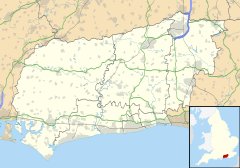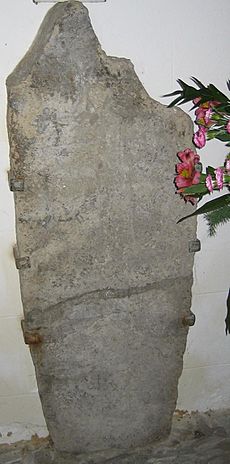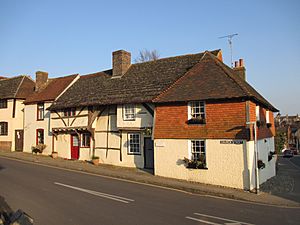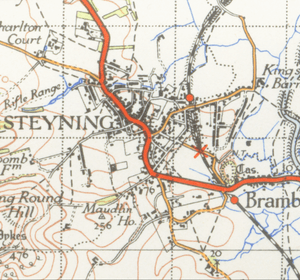Steyning facts for kids
Quick facts for kids Steyning |
|
|---|---|
| Town and civil parish | |
 High Street, Steyning town centre |
|
| Area | 15.74 km2 (6.08 sq mi) |
| Population | 5,812 2001 Census 5,990 (Census 2011) |
| • Density | 369/km2 (960/sq mi) |
| OS grid reference | TQ177110 |
| • London | 43 mi (69 km) NNE |
| Civil parish |
|
| District |
|
| Shire county | |
| Region | |
| Country | England |
| Sovereign state | United Kingdom |
| Post town | STEYNING |
| Postcode district | BN44 |
| Dialling code | 01903 |
| Police | Sussex |
| Fire | West Sussex |
| Ambulance | South East Coast |
| EU Parliament | South East England |
| UK Parliament |
|
Steyning (![]() i/ˈstɛnɪŋ/ STEN-ing) is a town and civil parish in the Horsham area of West Sussex, England. It is found at the north end of the River Adur gap in the South Downs. Steyning is about 4 miles (6 km) north of the coastal town of Shoreham-by-Sea.
i/ˈstɛnɪŋ/ STEN-ing) is a town and civil parish in the Horsham area of West Sussex, England. It is found at the north end of the River Adur gap in the South Downs. Steyning is about 4 miles (6 km) north of the coastal town of Shoreham-by-Sea.
The smaller villages of Bramber and Upper Beeding are also part of this built-up area. They are all located where the river can be crossed.
Contents
Steyning's Population and Land
The parish of Steyning covers an area of 1574 hectares (about 6 square miles). In 2001, 5,812 people lived in 2,530 homes. About 2,747 of these people were working.
Steyning's Rich History
Steyning has a very long history, going back to Anglo-Saxon times.
Saxon Beginnings
Legend says that St. Cuthman built a church in Steyning. He supposedly stopped there after carrying his mother in a wheelbarrow. Many signs when you enter Steyning show this story. The church was first named after him, then St Andrew, and now both.
King Alfred the Great's father, Ethelwulf of Wessex, was first buried in this church. Later, his body was moved to Winchester. A Saxon grave slab, possibly his, can still be seen in the church porch.
Norman Influence
To thank his Norman helpers, Edward the Confessor gave his royal church in Steyning to the Abbey Church of the Holy Trinity at Fécamp. This happened after Bishop Aelfwine of Winchester, who was in charge of Steyning, passed away in 1047. This meant the church was then directly under the Pope.
William confirmed this gift. He said the church would be free from all earthly service to lords and princes. It would have royal freedoms and justice over its lands. This was in addition to land near Rye, Winchelsea, and Hastings. These lands were given to the same Abbey by King Cnut.
By this time, Steyning was a busy and important port. It had a market, a royal mint, and two churches. The Domesday Book, written 60 years later, tells us this.
In 1052, Godwin, Earl of Wessex took Steyning for himself. His son Harold decided to keep it when he became king. This made sense because Harold did not want Normans controlling a possible invasion port. But William promised to get it back for the monks.
After his victory at Hastings, William kept his promise. He gave Steyning back to the monks. However, Steyning was very important for its location. So, William put William de Braose in charge of a new castle nearby in Bramber.
De Braose and the monks began to argue about land and power. The Domesday Book, finished in 1086, made things worse. It showed that de Braose had built a bridge at Bramber. He was charging tolls from ships going further up the river to Steyning. The monks said Bramber had no right to bury people in its churchyard. They wanted their burial fees.
In 1086, the king held a court to settle this. It took a whole day, but the Abbey won. De Braose had to lower his bridge tolls and stop taking the Abbey's land. He also had to move all the dead from Bramber to Saint Cuthman's Church in Steyning.
Later Medieval Times
The argument between Steyning and Bramber continued for centuries. This was made worse because the Lord of Bramber built his own religious places nearby. In the 1300s, the River Adur started to fill with mud. This made it hard for ships to use Steyning as a port. The town lost trade and people.
The monks from Fécamp Abbey controlled Steyning until the 1400s. In the 1200s, they changed the name of St Cuthman's church to St Andrew.
From 1278, Steyning sent two members to parliament. It became known as a "rotten borough." This meant it was a town that had lost most of its people but still had the right to send representatives to parliament. This continued until the Reform Act 1832.
Steyning in the 1600s
In 1614, William Holland, an important official from Chichester, started and funded Steyning Grammar School.
Steyning in the 1800s
The Steyning Line railway came to Steyning in 1861. This line connected London to Shoreham. A station was built for the town. You can see the black line and station on the map.
Steyning Town Hall, which is now an estate agent's office, was built in 1886 at 38 High Street.
The famous Irish politician Charles Stewart Parnell married 'Kitty' O'Shea here in 1891. This marriage was a big event that led to changes in his political career and caused disagreements in Irish politics.
In 1881, many people in Steyning worked in farming. There was also brewing, a tannery (where leather is made), and some brickmaking. More than 25 men worked with sheep as fellmongers (preparing animal skins). More than four were parchment makers, and five were millers. The town also had a surgeon, an oil painter named James M. Burfield, and a watchmaker.
The railway line served the town for over 100 years. It closed in 1966 because of the Beeching Axe. The old railway path is now a walking and cycling route called the Downs Link. The closest train station today is Shoreham-by-Sea.
Steyning Today
Steyning has three pubs: the Star Inn, the Chequer Inn, and the White Horse. There are also many restaurants and cafes. The Norfolk Arms, a historic pub, closed in 2021.
The town also has many shops, a health centre, a public library, and the Steyning Museum. A leisure centre was built with money from the National Lottery.
A spring fair is held every year on the Spring bank holiday (the last Monday in May).
The Monarch's Way is a long walking path that goes around the southern edge of the town.
Steyning has good public transport. The bus company Brighton & Hove runs route 2 every hour to Steyning. This bus comes from Rottingdean and goes through Brighton, Hove, and Shoreham-by-Sea.
Schools in Steyning
Steyning is home to Steyning Grammar School. It is now a large school with 2,500 students, including over 400 in the sixth form. The school was founded in the Stuart period. Students come from areas as far as Dial Post and sometimes Worthing. The town also has a primary school with 400 students and a pre-school.
Steyning Festival
The Steyning Festival started in 2006. It happens every two years for two weeks at the end of May and beginning of June. The festival includes theatre, music, literature, talks, walks, and community events.
In 2009, the Steyning Festival received a grant to bring artist Chris Dooks to Steyning. He stayed for a month and created a free MP3 tour of the town.
Sports and Leisure in Steyning
There is a long-standing cricket club near the police station. Steyning also has a non-league football club called Steyning Town Community Football Club. They play at the Shooting Field. The town also has its own leisure centre.
Steyning Athletic Club started in 1951. It offers many sports like running, swimming, cycling, and triathlon. The club holds annual events such as the Roundhill Romp (a 10k running race) and the Steyning Stinger (a full and half marathon on the South Downs).
Steyning is also home to a group from the Army Cadet Force. This is a national youth group for young people that is supported by the MoD.
Famous People from Steyning
- Peter Carter-Ruck, who started Carter-Ruck Solicitors, was born here in 1914.
- Major-General Sir Ernest Marshall Cowell, a military officer and surgeon, grew up in Steyning.
- E. M. Delafield, an author, was born and grew up in Steyning.
- Sally Gunnell, a former British athlete, won a gold medal in the 1992 Summer Olympic Games.
- Charles Handley-Read, a writer and collector of architecture, was born here in 1916.
- Bernard Holden, a railway engineer, lived in the Station Master's House from 1912. He went to Steyning Grammar School in the 1920s.
- Ray Jones, a priest, moved to Steyning in 2009 after retiring.
- Victor Benjamin Neuburg, an occultist and poet, owned the Vine Press.
- Elizabeth Norton, a historian and author, grew up in Steyning and went to Steyning Grammar School.
- Richard Raphael, a cricketer.
- W. B. Yeats, the Irish poet, stayed at the Chantry House in his later years.
- Maisie Peters, a singer-songwriter, was born in Steyning.
- Julia Donaldson, author of The Gruffalo and other popular children's books.
See also
 In Spanish: Steyning para niños
In Spanish: Steyning para niños








